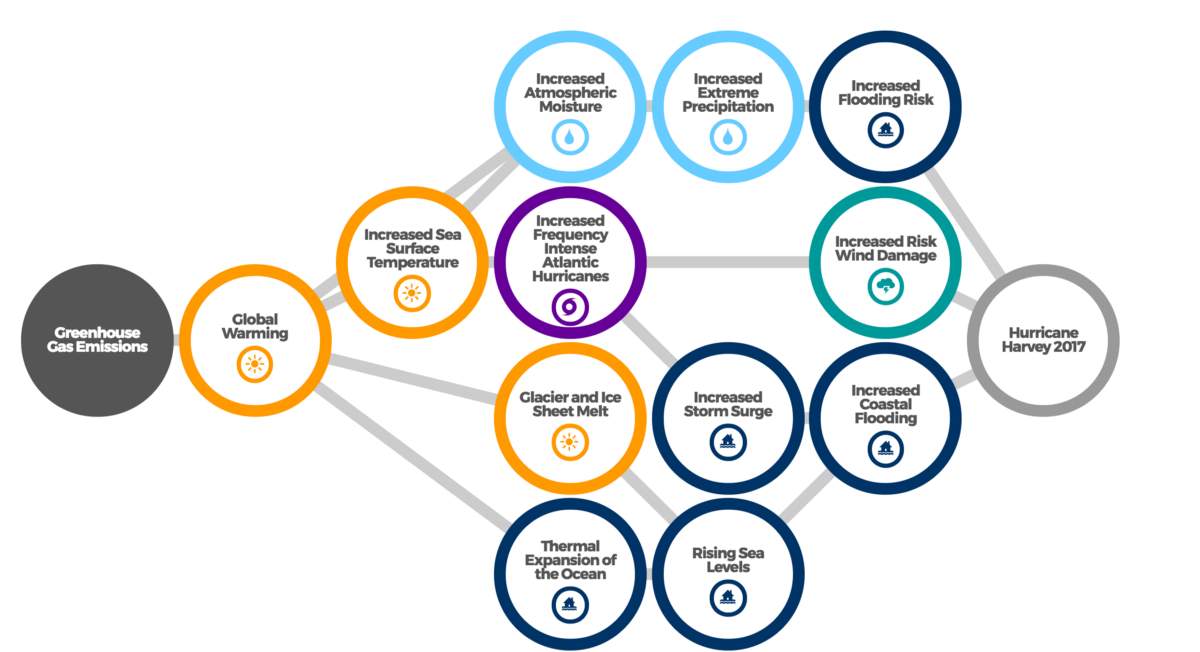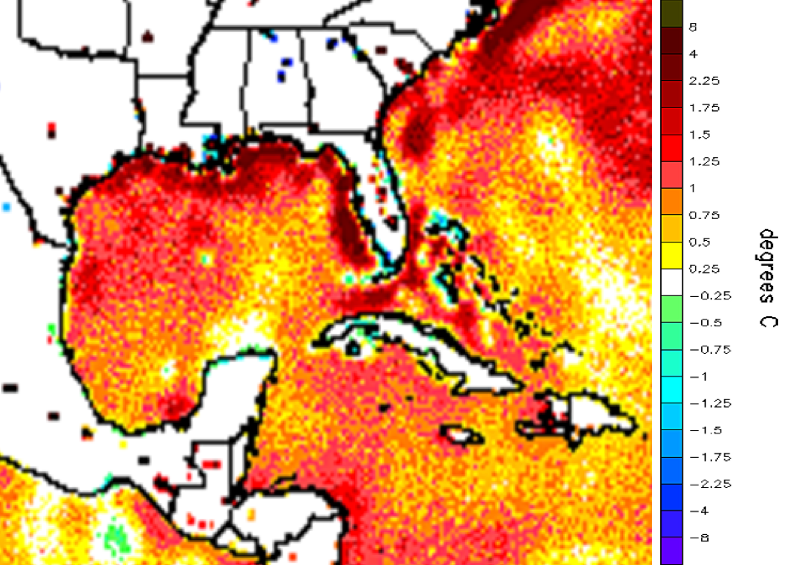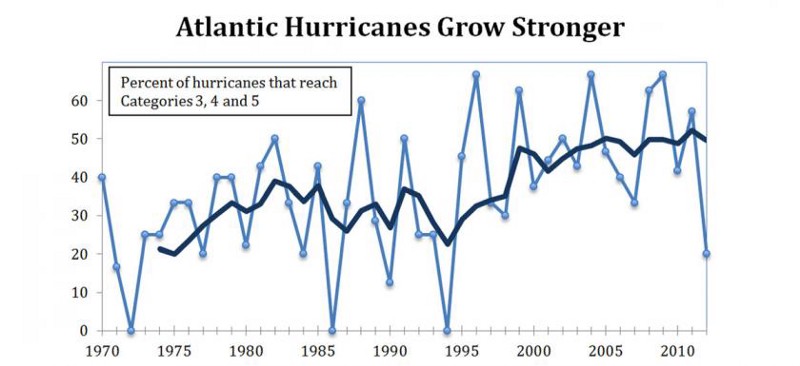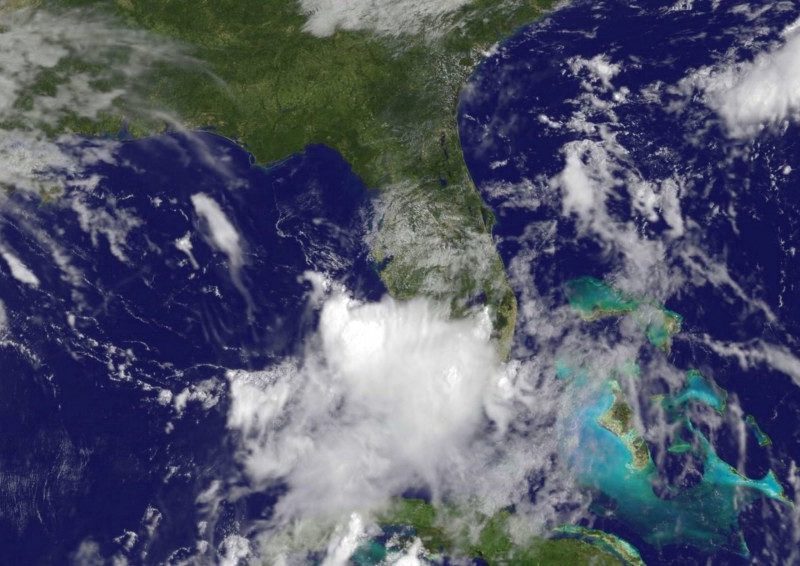Late Friday night, Hurricane Harvey made landfall near Rockport, Texas, the first Category 4 cyclone to hit the United States in nearly 12 years. The storm delivered winds up to 130 miles per hour and dumped more than 50 inches of rain on parts of Texas. Harvey reportedly has left 30 people dead and spurred thousands to evacuate.
The National Weather Service said the storm is “unprecedented and all impacts are unknown and beyond anything experienced.” Many are calling the storm a natural disaster, but by any reasonable measure, it was shaped by human hands.
Climate change is setting the conditions for punishing hurricanes like Harvey in three significant ways. First, warmer waters load the dice for stronger winds. Second, warmer air can hold more moisture, producing more intense rainfall. And third, rising seas extend the reach of coastal floods.

Warm waters are fertile ground for high-speed hurricanes.
Hurricanes form over ocean hot spots. Seas radiate warmth, heating the skies above. This lowers air pressure, creating a vacuum. Cooler winds from surrounding areas rush in to fill this vacuum, and a hurricane is born. Warmer waters effectively raise the speed limit for winds. The Atlantic hurricane season covers the summer and fall, when waters are warmest.
In recent decades, seas have gotten considerably warmer. Carbon pollution is trapping heat, and the oceans are absorbing almost all of it.That extra heat was just more ammunition for Hurricane Harvey. Cyclones form where waters are 26 degrees C or warmer. In the days leading up to Harvey, water temperatures in the Gulf of Mexico exceeded 30 degrees C. Waters were up to 4 degrees C hotter than they were in the latter half of the 20th century.

Warm air holds more water, producing heavier downpours.
When it’s warm, water evaporates faster than it condenses. This causes the atmosphere to hold more water vapor, which leads to heavier downpours. Harvey, already the worst deluge in U.S. history, has delivered several feet of rain to Houston and surrounding areas.
“The human contribution can be up to 30 percent or so of the total rainfall coming out of the storm,” Kevin Trenberth, climate scientist at the National Center for Atmospheric Research, told The Atlantic. “It may have been a strong storm, and it may have caused a lot of problems anyway — but [human-caused climate change] amplifies the damage considerably.”
Sea-level rise makes floods dramatically worse.
Climate change is raising sea levels by heating water and melting ice. Warmer waters take up more space than cooler waters, because water molecules move further apart when they heat up. Thermal expansion, as it’s known, is responsible for about one-third of recent sea-level rise. The rest is due to the melting of the polar ice caps. The oceans have risen about eight inches since the beginning of the 20th century.
The extra water can extend the reach of coastal floods. Harvey inflicted storm surges approaching six feet along parts of the Gulf Coast, inundating communities in Southeast Texas — floods that were made measurably worse by sea-level rise.
Hard to sleep with the roar of the wind in Port Lavaca TX as the eye of #Harvey makes its closest approach. Water rise record 5.5' so far. pic.twitter.com/mvYaluipxu
— Mike Seidel (@mikeseidel) August 26, 2017
Harvey is a climate-change storm.
Some people will ask if climate change caused Hurricane Harvey. That’s the wrong question. Carbon pollution is distorting the climate system, loading the dice for extreme weather. Sometimes, the human fingerprint is clear — record-breaking heat is almost invariably the result of climate change. Other times, it’s more muddy. So many factors contribute to the formation of a hurricane. It can be difficult to tease the signal from the noise.
What is certain is that rising temperatures are fueling more destructive hurricanes, including Harvey. Pennsylvania State University climate scientist Michael Mann wrote in The Guardian that climate change “worsened the impact of Hurricane Harvey.” It’s vital that the public understand the threat that climate change poses today.
UC Berkeley linguist George Lakoff argues that “climate scientists, trying to be precise, have too often shied away from attributing causation of a particular hurricane, drought or fire to global warming… Global warming is real, and it is here. It is causing — yes, causing — death, destruction and vast economic loss.”

Climate writer David Roberts has made a similar point, writing, “Scientific accuracy is a virtue. But affective impact and moral resonance are also virtues. We cannot say things we know are false about climate change, but we also cannot, in good conscience, be indifferent to whether our words have any effect.”
To that end, climate advocate Bill McKibben has called for hurricanes to be named after fossil fuel companies. It’s hard to imagine the World Meteorological Organization anointing a Hurricane Exxon — satisfying though that may be — but scientists, journalists and advocates can explain in clear terms how climate change is hurting Americans right now.
It’s clear that climate change is creating the conditions for more potent and dangerous storms. According to the 2014 National Climate Assessment, “The “intensity, frequency, and duration of North Atlantic hurricanes, as well as the frequency of the strongest hurricanes, have all increased since the early 1980s.” In the years ahead, it’s only going to get worse.
Given the unthinkable threat posed by the carbon crisis and the wealth of evidence linking rising temperatures to lethal storms, experts should call Harvey what it is — a climate-change storm.
Jeremy Deaton writes for Nexus Media, a syndicated newswire covering climate, energy, policy, art and culture. You can follow him @deaton_jeremy.


